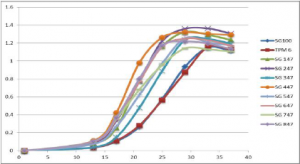Kevin Johnson and Dr. Joel Griffitts, MMBIO
Introduction
Organisms removed from their wild environment that are subjected to long term laboratory conditions can experience drastic change. We have specifically used Sinorhizobium meliloti as a model bacterium to address this topic. If soil bacteria containing large genomes necessary to survive in nutrient deficient and stressful conditions were suddenly subjected to nutrient rich and luxurious conditions for 2,500 generations, would they lose some survival based function? We hypothesize that without natural environmental stress, these bacteria would lose the metabolic flexibility previously required for survival resulting in large scale genome reduction.
Methodology
Evolution
Wild-type S. meliloti were grown in nutrient-rich broth in 8 replicates over 2,500 generations with daily transfer of cells to new media to maintain constant growth. 24 hours of growth represents approximately 9 generations of growth. Every week, samples from each of the 8 replicates were frozen down to make an evolutionary ‘fossil’ record.
In-vitro Competition Experiment
This test involved comparing the growth of the parent strain (generation 0) with the evolved strains 1-8 (generation 2,500). This was accomplished by placing the parent strains with one of the evolved strains in a test tube in equal proportions and allowing 48 hours of growth. The initial 1:1 ratio of parent to evolved strains was compared to the ratio of the strains after 48 hours of growth. A higher ratio in either direction indicates that either the evolved strain or parent strain has better evolutionary fitness in the test tube.
Since both strains look identical on a culture plate, we inserted the Lac operon into the parent strain. Lac is known as a reporter gene, and when bacteria containing Lac are grown on culture plates containing X-Gal, the colony turns blue. This allowed us to distinguish between mixed parent-strain bacteria and evolved bacteria in the same cultures.
The competition experiment compared the growth of bacteria in our specialized growth media, LB*, and in nutrient deficient media, SMM.
Growth Curves
This test aimed to graphically map-out the growth of each of our strains in LB* and SMM growth media. As bacteria grow in a test tube, the broth becomes more turbid (cloudy). Using a spectrophotometer, solution turbidity can be accurately measured and later plotted on a turbidity vs time graph.
Nodule Formation
In this test, each of the strains were inoculated on plants to determine which evolved strains still possessed the ability to nodulate and fix nitrogen for plants after 2,500 generations.
Results
Evolution
After 47 weeks of growth, we determined that each strain had surpassed the 2,500 generation mark. A PCR sequencing tests confirmed that all strains were still S. meliloti and had not been contaminated by any other bacterial strain.
In-vitro Competition Experiment
Our competition in rich broth, LB*, showed 1:1 ratio’s before and after 48 hours of growth in our control test tube. In all 8 of our evolved strain vs parent strain experiments, the evolved strains outcompeted the parent strain indicating faster growth. Strain 4 had the highest end ratio, indicated the fastest growth.
The competition experiment in nutrient deficient media, SMM, we obtained opposite results. The parent strain outcompeted all of the evolved strains and gained higher ratios after 72 hours of growth. Though very competitive in LB*, strain 4 had one of the lowest end ratio’s (slow growth) in SMM.
Growth Curves
We took growth curves of the 8 evolved strains and the control strains in LB* broth, then SMM broth. I have reproduced mini versions of the graphs below (LB*- left, SMM- right).


These growth curves show the bacteria density readings over time in hours. These results further support what was observed in the competition experiment. For example, the left graph in LB* media show strain 4 growing the fastest and the parent strain growing the slowest. However, in the SMM graph on the right, the parent strain is growing the fastest, and strain 4 is one of the slowest.
Nodule Formation
Evolved strains 5, 6, 8 were able to nodulate plants as well as the wild-type parent strain. Strain 1 completely lost this ability. Strains 2, 3, 4, and 7 partially lost this ability.
Discussion/Conclusion
Ultimately, our evolutionary pressure using nutrient rich media successfully selected for faster growing bacteria as demonstrated in the LB* competition and LB* growth curves. However, as hypothesized, these gains came at a cost to other functions resulting in slower growth in SMM and loss of plant interacting functions. Future steps should further explore the inhibited relationship with plants in some of these strains. Genomic sequencing and analysis might also shed light on the specific genes responsible for these loss-of-function and beneficial mutations.
